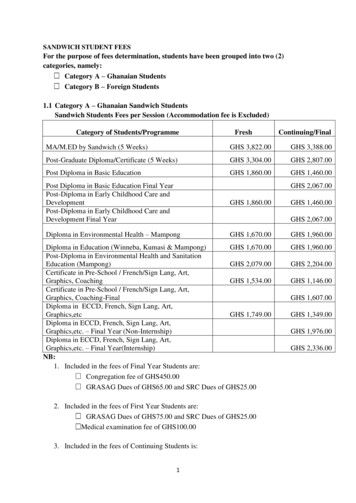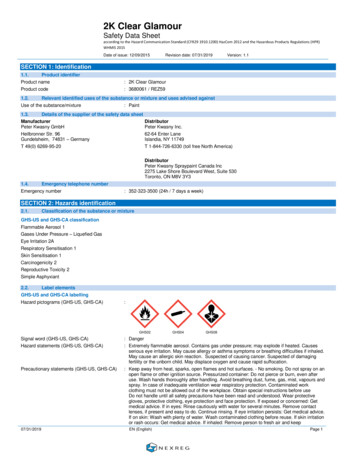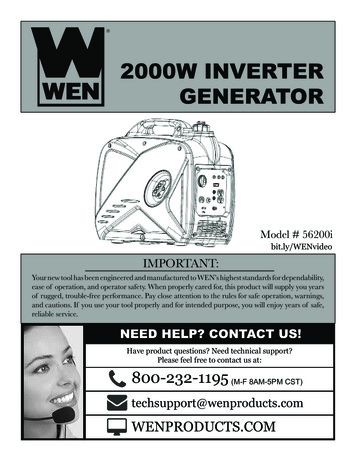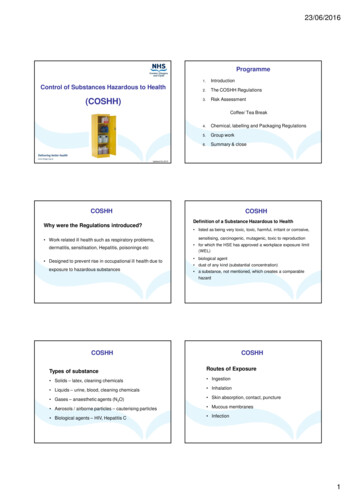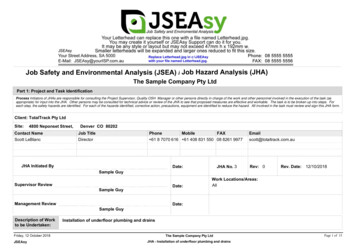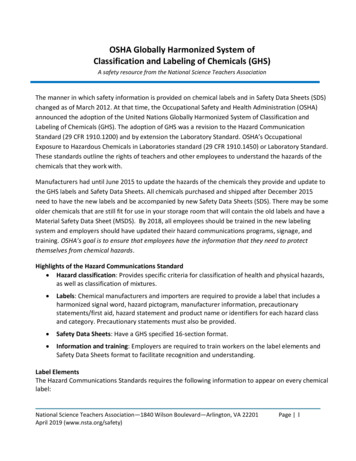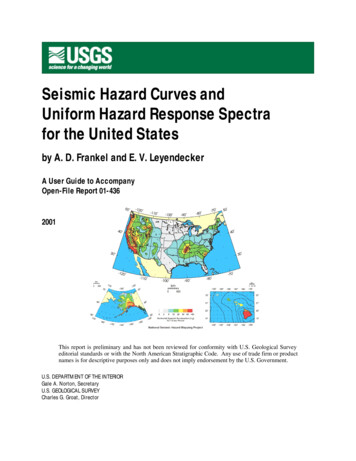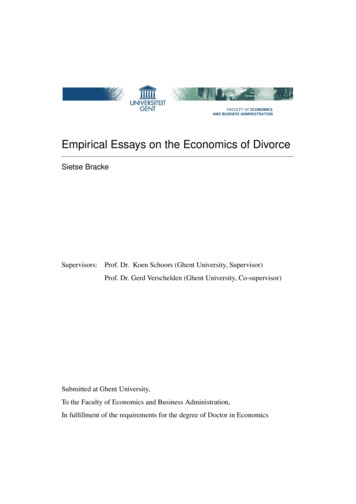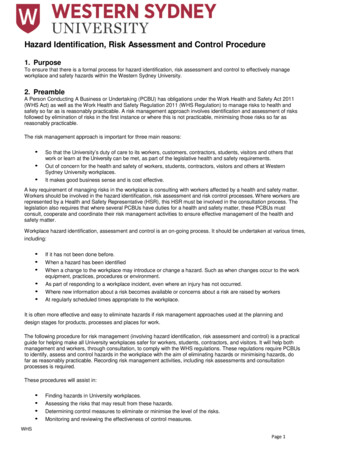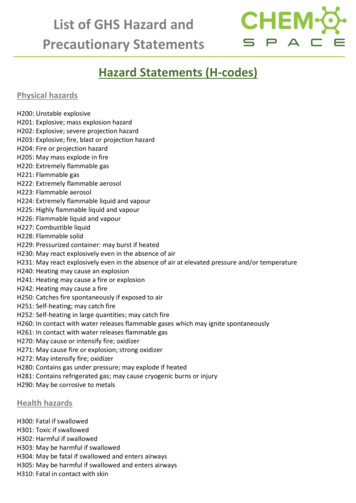
Transcription
List of GHS Hazard andPrecautionary StatementsHazard Statements (H-codes)Physical hazardsH200: Unstable explosiveH201: Explosive; mass explosion hazardH202: Explosive; severe projection hazardH203: Explosive; fire, blast or projection hazardH204: Fire or projection hazardH205: May mass explode in fireH220: Extremely flammable gasH221: Flammable gasH222: Extremely flammable aerosolH223: Flammable aerosolH224: Extremely flammable liquid and vapourH225: Highly flammable liquid and vapourH226: Flammable liquid and vapourH227: Combustible liquidH228: Flammable solidH229: Pressurized container: may burst if heatedH230: May react explosively even in the absence of airH231: May react explosively even in the absence of air at elevated pressure and/or temperatureH240: Heating may cause an explosionH241: Heating may cause a fire or explosionH242: Heating may cause a fireH250: Catches fire spontaneously if exposed to airH251: Self-heating; may catch fireH252: Self-heating in large quantities; may catch fireH260: In contact with water releases flammable gases which may ignite spontaneouslyH261: In contact with water releases flammable gasH270: May cause or intensify fire; oxidizerH271: May cause fire or explosion; strong oxidizerH272: May intensify fire; oxidizerH280: Contains gas under pressure; may explode if heatedH281: Contains refrigerated gas; may cause cryogenic burns or injuryH290: May be corrosive to metalsHealth hazardsH300: Fatal if swallowedH301: Toxic if swallowedH302: Harmful if swallowedH303: May be harmful if swallowedH304: May be fatal if swallowed and enters airwaysH305: May be harmful if swallowed and enters airwaysH310: Fatal in contact with skin
List of GHS Hazard andPrecautionary StatementsH311: Toxic in contact with skinH312: Harmful in contact with skinH313: May be harmful in contact with skinH314: Causes severe skin burns and eye damageH315: Causes skin irritationH316: Causes mild skin irritationH317: May cause an allergic skin reactionH318: Causes serious eye damageH319: Causes serious eye irritationH320: Causes eye irritationH330: Fatal if inhaledH331: Toxic if inhaledH332: Harmful if inhaledH333: May be harmful if inhaledH334: May cause allergy or asthma symptoms or breathing difficulties if inhaledH335: May cause respiratory irritationH336: May cause drowsiness or dizzinessH340: May cause genetic defectsH341: Suspected of causing genetic defectsH350: May cause cancerH351: Suspected of causing cancerH360: May damage fertility or the unborn childH361: Suspected of damaging fertility or the unborn childH361d: Suspected of damaging the unborn childH361f: Suspected of damaging fertilityH362: May cause harm to breast-fed childrenH370: Causes damage to organsH371: May cause damage to organsH372: Causes damage to organs through prolonged or repeated exposureH373: May cause damage to organs through prolonged or repeated exposureH300 H310: Fatal if swallowed or in contact with skinH300 H330: Fatal if swallowed or if inhaledH310 H330: Fatal in contact with skin or if inhaledH300 H310 H330: Fatal if swallowed, in contact with skin or if inhaledH301 H311: Toxic if swallowed or in contact with skinH301 H331: Toxic if swallowed or if inhaledH311 H331: Toxic in contact with skin or if inhaledH301 H311 H331: Toxic if swallowed, in contact with skin or if inhaledH302 H312: Harmful if swallowed or in contact with skinH302 H332: Harmful if swallowed or if inhaledH312 H332: Harmful in contact with skin or if inhaledH302 H312 H332: Harmful if swallowed, in contact with skin or if inhaledEnvironmental hazardsH400: Very toxic to aquatic lifeH401: Toxic to aquatic lifeH402: Harmful to aquatic life
List of GHS Hazard andPrecautionary StatementsH410: Very toxic to aquatic life with long-lasting effectsH411: Toxic to aquatic life with long-lasting effectsH412: Harmful to aquatic life with long-lasting effectsH413: May cause long-lasting harmful effects to aquatic lifeH420: Harms public health and the environment by destroying ozone in the upper atmosphereCountry-specific hazard statementsEuropean UnionPhysical propertiesEUH001: Explosive when dryEUH006: Explosive with or without contact with air, deleted in the fourth adaptation to technical progress ofCLP.EUH014: Reacts violently with waterEUH018: In use may form flammable/explosive vapour-air mixtureEUH019: May form explosive peroxidesEUH044: Risk of explosion if heated under confinementHealth propertiesEUH029: Contact with water liberates toxic gasEUH031: Contact with acids liberates toxic gasEUH032: Contact with acids liberates very toxic gasEUH066: Repeated exposure may cause skin dryness or crackingEUH070: Toxic by eye contactEUH071: Corrosive to the respiratory tractEnvironmental propertiesEUH059: Hazardous to the ozone layer, superseded by GHS Class 5.1 in the second adaptation to technicalprogress of CLP.Other EU hazard statementsEUH201: Contains lead. Should not be used on surfaces liable to be chewed or sucked by children.EUH201A: Warning! Contains lead.EUH202: Cyanoacrylate. Danger. Bonds skin and eyes in seconds. Keep out of the reach of children.EUH203: Contains chromium(VI). May produce an allergic reaction.EUH204: Contains isocyanates. May produce an allergic reaction.EUH205: Contains epoxy constituents. May produce an allergic reaction.EUH206: Warning! Do not use together with other products. May release dangerous gases (chlorine).EUH207: Warning! Contains cadmium. Dangerous fumes are formed during use. See information supplied bythe manufacturer. Comply with the safety instructions.EUH208: Contains name of sensitising substance . May produce an allergic reaction.EUH209: Can become highly flammable in use.EUH209A: Can become flammable in use.EUH210: Safety data sheet available on request.EUH401: To avoid risks to human health and the environment, comply with the instructions for use.
List of GHS Hazard andPrecautionary StatementsPrecautionary StatementsGeneral precautionary statementsP101: If medical advice is needed, have product container or label at hand.P102: Keep out of reach of children.P103: Read label before use.Prevention precautionary statementsP201: Obtain special instructions before use.P202: Do not handle until all safety precautions have been read and understood.P210: Keep away from heat, hot surfaces, sparks, open flames and other ignition sources. No smoking.P211: Do not spray on an open flame or other ignition source.P220: Keep/Store away from clothing/ /combustible materials.P221: Take any precaution to avoid mixing with combustibles.P222: Do not allow contact with air.P223: Do not allow contact with water.P230: Keep wetted with P231: Handle under inert gas.P232: Protect from moisture.P233: Keep container tightly closed.P234: Keep only in original container.P235: Keep cool.P240: Ground/bond container and receiving equipment.P241: Use explosion-proof electrical/ventilating/lighting/ /equipment.P242: Use only non-sparking tools.P243: Take precautionary measures against static discharge.P244: Keep valves and fittings free from oil and grease.P250: Do not subject to grinding/shock/ /friction.P251: Do not pierce or burn, even after use.P260: Do not breathe dust/fumes/gas/mist/vapours/spray.P261: Avoid breathing dust/fumes/gas/mist/vapours/sprayP262: Do not get in eyes, on skin, or on clothing.P263: Avoid contact during pregnancy/while nursing.P264: Wash thoroughly after handling.P270: Do not eat, drink or smoke when using this product.P271: Use only outdoors or in a well-ventilated area.P272: Contaminated work clothing should not be allowed out of the workplace.P273: Avoid release to the environment.P280: Wear protective gloves/protective clothing/eye protection/face protection.P282: Wear cold insulating gloves/face shield/eye protection.P283: Wear fire/flame resistant/retardant clothing.P284: [In case of inadequate ventilation] wear respiratory protectionP231 232: Handle under inert gas. Protect from moistureP235 410: Keep cool. Protect from sunlight
List of GHS Hazard andPrecautionary StatementsResponse precautionary statementsP301: IF SWALLOWED:P302: IF ON SKIN:P303: IF ON SKIN (or hair):P304: IF INHALED:P305: IF IN EYES:P306: IF ON CLOTHING:P307: [Deleted by IV ATP]P308: If exposed or concerned:P309: [Deleted by IV ATP]P310: Immediately call a POISON CENTER/doctor/ P311: Call a POISON CENTER/ doctor/ P312: Call a POISON CENTER/ doctor/ /if you feel unwell.P313: Get medical advice/attention.P314: Get medical advice/attention if you feel unwell.P315: Get immediate medical advice/attention.P320: Specific treatment is urgent (see on this label).P321: Specific treatment (see on this label).P330: Rinse mouth.P331: Do NOT induce vomiting.P332: If skin irritation occurs:P333: If skin irritation or a rash occurs:P334: Immerse in cool water/wrap in wet bandages.P335: Brush off loose particles from skin.P336: Thaw frosted parts with lukewarm water. Do not rub affected areas.P337: If eye irritation persists:P338: Remove contact lenses if present and easy to do. Continue rinsing.P340: Remove person to fresh air and keep comfortable for breathing.P342: If experiencing respiratory symptoms:P351: Rinse cautiously with water for several minutes.P352: Wash with plenty of water/ P353: Rinse skin with water/shower.P360: Rinse immediately contaminated clothing and skin with plenty of water before removing clothes.P361: Take off immediately all contaminated clothing.P362: Take off contaminated clothing.P363: Wash contaminated clothing before reuse.P364: And wash it before reuse.P370: In case of fire:P371: In case of major fire and large quantities:P372: Explosion risk in case of fire.P373: DO NOT fight fire when fire reaches explosives.P374: Fight fire with normal precautions from a reasonable distance.P375: Fight fire remotely due to the risk of explosion.P376: Stop leak if safe to do so.P377: Leaking gas fire – do not extinguish unless leak can be stopped safely.P378: Use to extinguish.P380: Evacuate area.
List of GHS Hazard andPrecautionary StatementsP381: Eliminate all ignition sources if safe to do so.P391: Collect spillage.P301 310: IF SWALLOWED: Immediately call a POISON CENTER/doctor/ P301 312: IF SWALLOWED: Call a POISON CENTER/doctor/ /if you feel unwell.P301 330 331: IF SWALLOWED: Rinse mouth. Do NOT induce vomiting.P302 334: IF ON SKIN: Immerse in cool water/wrap in wet bandages.P302 352: IF ON SKIN: Wash with plenty of water/ P303 361 353: IF ON SKIN (or hair): Take off immediately all contaminated clothing. Rinse skin with water/shower.P304 312: IF INHALED: Call a POISON CENTER or doctor/physician if you feel unwell.P304 340: IF INHALED: Remove person to fresh air and keep comfortable for breathing.P305 351 338: IF IN EYES: Rinse cautiously with water for several minutes. Remove contact lenses if presentand easy to do – continue rinsing.P306 360: IF ON CLOTHING: Rinse immediately contaminated clothing and skin with plenty of water beforeremoving clothes.P308 311: If exposed or concerned: Call a POISON CENTER/ doctor/ P308 313: If exposed: Call a POISON CENTER or doctor/physician.P332 313: If skin irritation occurs: Get medical advice/attention.P333 313: If skin irritation or a rash occurs: Get medical advice/attention.P335 334: Brush off loose particles from skin. Immerse in cool water/wrap in wet bandages.P337 313: If eye irritation persists get medical advice/attention.P342 311: If experiencing respiratory symptoms: Call a POISON CENTER/doctor/ P361 364: Take off immediately all contaminated clothing and wash it before reuse.P362 364: Take off contaminated clothing and wash it before reuse.P370 376: In case of fire: Stop leak if safe to do so.P370 378: In case of fire: Use to extinguish.P370 380: In case of fire: Evacuate area.P370 380 375: In case of fire: Evacuate area. Fight fire remotely due to the risk of explosion.P371 380 375: In case of major fire and large quantities: Evacuate area. Fight fire remotely due to the risk ofexplosion.Storage precautionary statementsP401: Store P402: Store in a dry place.P403: Store in a well ventilated place.P404: Store in a closed container.P405: Store locked up.P406: Store in a corrosive resistant/ container with a resistant inner liner.P407: Maintain air gap between stacks/pallets.P410: Protect from sunlight.P411: Store at temperatures not exceeding C/ F.P412: Do not expose to temperatures exceeding 50 C/122 F.P413: Store bulk masses greater than kg/ lbs at temperatures not exceeding C/ F.P420: Store away from other materials.P422: Store contents under P402 404: Store in a dry place. Store in a closed container.P403 233: Store in a well ventilated place. Keep container tightly closed.
List of GHS Hazard andPrecautionary StatementsP403 235: Store in a well ventilated place. Keep cool.P410 403: Protect from sunlight. Store in a well-ventilated place.P410 412: Protect from sunlight. Do not expose to temperatures exceeding 50 C/122 F.P411 235: Store at temperatures not exceeding C/ F. Keep cool.Disposal precautionary statementsP501: Dispose of contents/container to [ in accordance with local/regional/national/internationalregulation (to be specified)].
Storage precautionary statements P401: Store P402: Store in a dry place. P403: Store in a well ventilated place. P404: Store in a closed container. P405: Store locked up. P406: Store in a corrosive resistant/ container with a resistant inner liner. P407: Maintain air gap between stacks/pallets. P410: Protect from sunlight.
